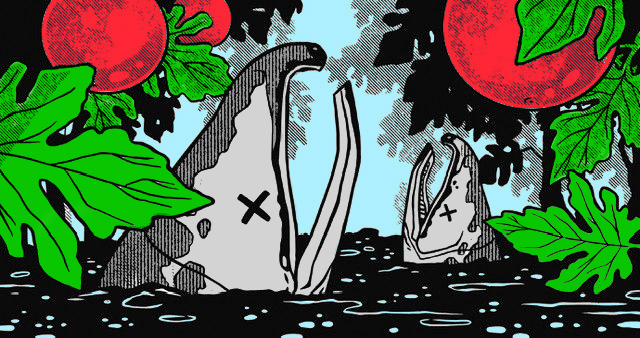
Do you have any fish heads?” I ask the woman behind the seafood counter.
“Sure, how many would you like?”
“How many do you have?”
“We have four boxes,” she replies.
“Of fish heads?”
“No, these are whole salmon. I’ll cut as many heads as you want.” We settle on four heads, slightly over four pounds, at about three dollars a pound.
The couple waiting their turn after me are trying not to laugh. What’s up with this lady? Who’d eat fish heads, yuck, with eyeballs! Do they even make good stock?
“They’re for my tomatoes. When I dig a hole for each plant, the first thing I put in is a fish head. It’s like slow-release nitrogen.” I give them the rest of the ingredient list for my soil, which I got from a nursery that specializes in tomatoes: bonemeal, regular vegetable fertilizer, earthworm castings, eggshells (plants need calcium, too), and two aspirin, because tomatoes like soil on the acidic side. “And yes, it works.”
“Really?” says the man. “Maybe I’ll try that.”
Oh well. My first task when I get home is to cleave those big heads in two and add a frozen fish head and backbone from a whole snapper, thus yielding enough for the nine tomatoes I’m about to plant.
Slimy, sticky, tough. While sawing away, I realize these heads include the collars, the part that makes a circle between the gills and the rest of the fish. There’s enough fish meat in the collars for four individual meals. From the meatier upper parts, I get chunks of salmon to steam with ginger and scallions; the lower parts are good for chowder with leeks and yellow beets. And three dollars a pound!
As I cut through each head vertically, their permanently startled looks stare back at me. And here I am getting ready to feed them to plants. The alluring romance of wild salmon—fighting their way back to where they were born, with beautiful, battered bodies and ultimately dying—vividly fills my thoughts. Is this right? I guess that’s one advantage of these salmon being farm raised; they weren’t ever going anywhere except to someone’s dinner plate. And their heads would have probably been discarded.
Instead they will nourish my tomatoes—four kinds this year. Combine that with two types of sweet corn, fava beans, and lettuce. My young cucumber and squash plants are getting bigger every day, and the basil just germinated.
After losing my husband four Summers ago, I now give away a lot of what I grow. Since I learned how to plant my own food 50 years ago, I’ve done it wherever I had the space.
Gardening is a lot of work, and all the digging and bending takes a toll—but I enjoy it and enjoy sharing the bounty. Might as well strive to do it right.
Honor the salmon. Honor the tomatoes. And most of all, honor the gift of—still—being able to garden. ❖


 Previous
Previous


What a wonderful, interesting article. Everything you do honors life of all kinds. You are inspiring this wanna be gardener.